 | |
| Rules required | Dungeons & Dragons, 3.5 edition |
|---|---|
| Character levels | 4th |
| Authors | Christopher Perkins |
| First published | September 2005 |
Sons of Gruumsh is an adventure module for the 3.5 edition of the Dungeons & Dragons fantasy role-playing game.
 | |
| Rules required | Dungeons & Dragons, 3.5 edition |
|---|---|
| Character levels | 4th |
| Authors | Christopher Perkins |
| First published | September 2005 |
Sons of Gruumsh is an adventure module for the 3.5 edition of the Dungeons & Dragons fantasy role-playing game.
Sons of Gruumsh takes place in the Forgotten Realms setting, and involves six missing nobles from Melvaunt, as tribes of orcs in Thar converge on the ruined fortress of Xûl-Jarak, flocking to the banner of a charismatic warlord.
Sons of Gruumsh was published in September 2005, and was written by Christopher Perkins, with cover art by Todd Lockwood and interior art by Mike Dubisch.
Dungeon Master for Dummies lists Sons of Gruumsh as one of the ten best 3rd edition adventures. [1]

The Dungeon Master's Guide is a book of rules for the fantasy role-playing game Dungeons & Dragons. The Dungeon Master's Guide contains rules concerning the arbitration and administration of a game, and is intended for use by the game's Dungeon Master.
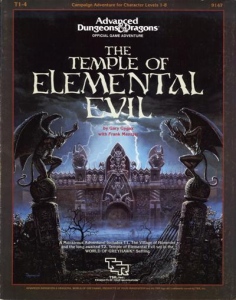
The Temple of Elemental Evil is an adventure module for the fantasy role-playing game Dungeons & Dragons, set in the game's World of Greyhawk campaign setting. The module was published by TSR, Inc. in 1985 for the first edition Advanced Dungeons & Dragons rules. It was written by Gary Gygax and Frank Mentzer, and is an expansion of an earlier Gygax module, The Village of Hommlet. The Temple of Elemental Evil is also the title of a related 2001 Thomas M. Reid novel and an Atari computer game.

Tomb of Horrors is an adventure module written by Gary Gygax for the Dungeons & Dragons (D&D) role-playing game. It was originally written for and used at the 1975 Origins 1 convention. Gygax designed the adventure both to challenge the skill of expert players in his own campaign and to test players who boasted of having mighty player characters able to best any challenge. The module, coded S1, was the first in the S-series, or special series of modules. Several versions of the adventure have been published, the first in 1978, and the most recent, for the fifth edition of D&D, in 2017 as one of the included adventures in Tales from the Yawning Portal. The module also served as the basis for a novel published in 2002.

Ravenloft is an adventure module for the Dungeons & Dragons (D&D) fantasy role-playing game. The American game publishing company TSR, Inc. released it as a standalone adventure booklet in 1983 for use with the first edition Advanced Dungeons & Dragons game. It was written by Tracy and Laura Hickman, and includes art by Clyde Caldwell with maps by David Sutherland III. The plot of Ravenloft focuses on the villain Strahd von Zarovich, a vampire who pines for his lost love. Various story elements, including Strahd's motivation and the locations of magical weapons, are randomly determined by drawing cards. The player characters attempt to defeat Strahd and, if successful, the adventure ends.
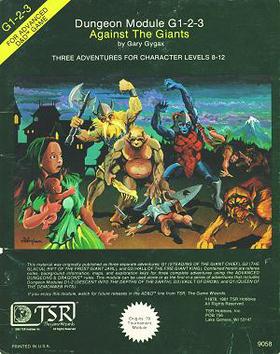
Against the Giants is an adventure module written by Gary Gygax and published by TSR in 1981 for the Dungeons & Dragons fantasy role-playing game. It combines the G series of modules previously published in 1978: Steading of the Hill Giant Chief, Glacial Rift of the Frost Giant Jarl, and Hall of the Fire Giant King. All three were produced for use with the 1st edition Advanced Dungeons & Dragons rules. In 1999, to recognize the 25th anniversary of TSR, the company released an updated version, Against the Giants: The Liberation of Geoff. Later in 1999, Wizards of the Coast published a novelization of Against the Giants by Ru Emerson.

In the Dungeons & Dragons role-playing game, an adventure or module is a guide for managing player knowledge and activities within a specific scenario. Commercially, a published adventure comes as a pre-packaged book or box set that is used exclusively by the Dungeon Master. It typically contains background information for the plot or story, maps, vignettes of interesting locations, site inventories, creature descriptions and statistics, player visual aids, and suggested rules for evaluating events and likely player actions.

The Hidden Shrine of Tamoachan is an adventure module for the Dungeons & Dragons (D&D) fantasy role-playing game, set in the World of Greyhawk campaign setting for use with the 1st edition Advanced Dungeons & Dragons rules. It is the first in the C-series of modules, a set of unrelated adventures originally designed for competitive play, with the C representing the first letter in the word competition. It is the first D&D adventure to use boxed, "read aloud" text.

White Plume Mountain is an adventure module for the Advanced Dungeons & Dragons fantasy role-playing game, written by Lawrence Schick and published by TSR in 1979. The 16-page adventure bears the code "S2". The adventure is a dungeon crawl where the players' characters are hired to retrieve three "notorious" magical weapons, each possessing its own intelligence. The adventure contains art by Erol Otus, and a cover by Jeff Dee. A sequel, Return to White Plume Mountain, was published in 1999, and an updated version conforming to v3.5 rules was released online in 2005. The original was again updated for the 5th edition in 2017 as the fourth part of Tales from the Yawning Portal.

Mordenkainen's Fantastic Adventure by Robert J. Kuntz and Gary Gygax is an adventure module for the Dungeons & Dragons role-playing game, published by TSR, Inc. in 1984. It originally bore the code "WG5" and was intended for use with the Advanced Dungeons & Dragons first edition rules. Because it is one of the WG modules, it is a module intended for the World of Greyhawk campaign setting. It was later updated in 2004 to the Third Edition Revised rules in Dungeon magazine, issue #112, as Maure Castle. There were subsequently two additional installments in issues #124 and #139.
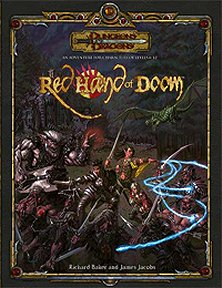
Red Hand of Doom is a 128-page adventure module for the 3.5 version of Dungeons & Dragons (D&D). It is designed as a generic D&D adventure that can be dropped into any campaign world, including a personal one. Instructions are given in the first pages of the module on where to place it in the worlds of Greyhawk, the Forgotten Realms, and Eberron.
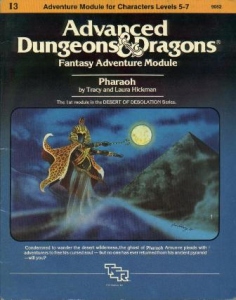
Pharaoh is an adventure module for the Dungeons & Dragons fantasy role-playing game. The module was published in 1982 by TSR, Inc. for the first edition Advanced Dungeons & Dragons rules. It formed the first of the three-part Desert of Desolation module series. The module was written by Tracy and Laura Hickman; Tracy Hickman would later go on to help create the Dragonlance campaign setting.

Desert of Desolation is a compilation adventure module published by TSR for the Dungeons & Dragons (D&D) fantasy roleplaying game. It combines three previously published individual modules: Pharaoh, Oasis of the White Palm, and Lost Tomb of Martek. The modules were made for use with the first edition Advanced Dungeons & Dragons (AD&D) rules. Pharaoh was created by Tracy and Laura Hickman soon after the couple married in 1977, and published by TSR in 1982. Oasis of the White Palm was a collaboration between Tracy Hickman and Philip Meyers, and Hickman wrote the Lost Tomb of Martek on his own; both were printed in 1983.

City of the Spider Queen is a 160-page adventure module set in the Forgotten Realms campaign setting, for use with the 3rd edition of the fantasy role-playing game Dungeons & Dragons.

The Sunless Citadel is an adventure module for the 3rd edition of the Dungeons & Dragons fantasy role-playing game.

Lord of the Iron Fortress is an adventure module for the 3rd edition of the Dungeons & Dragons fantasy role-playing game.
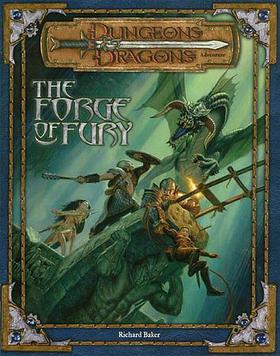
The Forge of Fury is an adventure module for the 3rd edition of the Dungeons & Dragons fantasy tabletop role-playing game.

The Speaker in Dreams is an adventure module for the 3rd edition of the Dungeons & Dragons fantasy role-playing game.

Shadows of the Last War is an adventure module for the 3.5 edition of the Dungeons & Dragons fantasy role-playing game.

Whispers of the Vampire's Blade is an adventure module for the 3.5 edition of the Dungeons & Dragons fantasy role-playing game.

In the Dungeons & Dragons role-playing game, Corellon Larethian is the leader of the elven pantheon, and the god of Magic, Music, Arts, Crafts, Poetry, and Warfare. Corellon is also considered a member of the default D&D pantheon. Corellon is the creator and preserver of the elven race, and governs those things held in the highest esteem among elves. Corellon's symbol was originally a crescent moon; in the 4th edition Corellon's symbol is a silver star on a blue field.